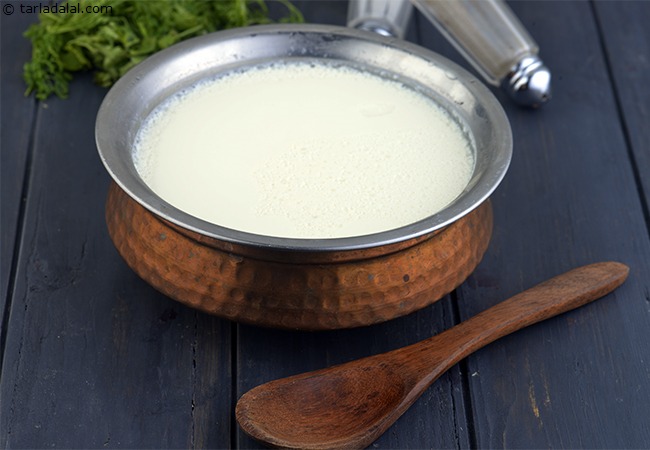Moong Dal, Nachni and Paneer Paratha recipe makes 6 parathas of 30 grams each.
144 calories for 1 Moong Dal and Paneer Paratha ( Gluten Free Recipe), Cholesterol 0 mg, Carbohydrates 20g, Protein 6.2g, Fat 4.3g. Find how much fibre, iron, calcium, zinc, magnesium, phosphorus, sodium, potassium, folic acid is present in Moong Dal and Paneer Paratha ( Gluten Free Recipe)
See Moong Dal, Nachni and Paneer Paratha recipe | green moong dal paneer paratha recipe | dal paneer paratha using ragi flour | healthy nachni dal paratha | gluten free moong dal paratha | with 20 amazing images.
Green Moong Paneer Paratha made using ragi flour is a nutritious and wholesome variation of the traditional paratha. Ragi flour, also known as finger millet flour, is a gluten-free grain that is rich in fiber, calcium, and other essential nutrients. When combined with green moong dal and paneer, it creates a balanced and protein-packed meal option.
To make Green Moong Paneer Paratha with ragi flour, the cooked green moong dal and crumbled paneer are mixed with ragi flour, coriander and spices to form a soft and pliable dough. This dough is then divided into portions, rolled out into flatbreads, and cooked on a hot griddle with a little oil or ghee until crispy and golden brown.
The addition of ragi flour not only enhances the nutritional profile of the paratha but also adds a nutty flavor and a unique texture to the dish. Ragi flour is known for its health benefits, including aiding in weight management, improving bone health, and regulating blood sugar levels.
Green Moong Paneer Paratha made with ragi flour can be served with yogurt, chutney, or a side of vegetables for a complete and satisfying meal. It is a great way to incorporate the goodness of ragi into your diet while enjoying a delicious and filling dish.
Pro tips for Green Moong Paneer Paratha 1. In a bowl put 1/2 cup ragi (nachni / red millet) flour. Ragi flour is naturally gluten-free, making it a suitable option for people with gluten intolerance or celiac disease. This allows them to enjoy a delicious paratha without worrying about gluten. While not as strong as wheat flour, ragi flour has some binding properties that help hold the dough together. 2. Add 1/2 cup green moong dal (split green gram) soaked and cooked. The lentils have a nutty, slightly sweet flavor that compliments the savory paneer. Additionally, the cooked dal provides a soft and slightly mashed texture, contrasting with the paneer. The cooked dal adds moisture to the paratha filling, helping to prevent it from becoming dry and crumbly. 3. Add 1/4 cup crumbled paneer (cottage cheese). Paneer can add a touch of richness to the green moong dal, making it more flavorful and satisfying. Paneer contains high quality protein and calcium which aids in weight loss. Since paneer is low in carbs and high in protein it gets digested slowly and hence good for diabetes.
Is Moong Dal, Nachni and Paneer Paratha healthy?
Yes, this is healthy. But restrictions apply to some.
Let's understand the Ingredients.
What's good.
1. Moong Dal ( Green Moong Dal ) : Moong dal or green moong dal is rich in Folate, Vitamin B9 or Folic Acid which helps your body to produce and maintain new cells, especially red blood cells and is pregnancy friendly. Being rich in Antioxidants like Flavonoids, mung reduces the damage done by free radicals to the blood vessels and lowers inflammation. Moong Dal is heart and diabetes friendly. Moong Dal or Split Green Gram are high in Fibre and 1 cup of cooked Moong dal gives 28.52% of your daily Fibre requirements. See here for 9 fabulous benefits of Moong Dal.
2. Ragi flour ( Nachni flour) : Ragi flour is high in protein and great source for vegetarians. In addition its gluten free, high in fiber which in turn is good for diabetics and a healthy heart. Ragi flour creates a much lower surge in sugar levels compared to wheat. Ragi is rich in Magnesium which improves insulin response by lowering insulin resistance. A must read for the benefits of ragi to include in your daily diet.
3. Paneer : Paneer contains high quality protein and calcium which aids in weight loss. Since paneer is low in carbs and high in protein it gets digested slowly and hence good for diabetes. Potassium in paneer helps to reduce the effect of high sodium, by lowering blood pressure and contraction of blood vessels, resulting in improved heart health and reduced risk of heart attack.Great for weight loss and read the interesting article on is paneer good for you?
Can diabetics, heart patients and over weight individuals have Moong Dal, Nachni and Paneer Paratha ?
Yes. Use low fat paneer in the recipe. Moong Dal is heart and diabetes friendly. Ragi flour is gluten free, high in fiber which in turn is good for diabetics and a healthy heart.
Can healthy individuals have Moong Dal, Nachni and Paneer Paratha ?
Yes, this is healthy. We suggest you pair it with homemade curds using cows milk or low fat curds.

Basic Homemade Curd, Dahi Or Yogurt Using Cow's Milk
Moong Dal, Nachni and Paneer Paratha is high in
1. Phosphorous : Phosphorous works closely with calcium to build bones.
Note : a recipe is deemed high in a Vitamin or mineral if it meets 20% and above the recommended daily allowance based on a 2,000 calorie diet.
How to burn 139 calories that come from one Moong Dal, Nachni and Paneer Paratha?
| Walking (6 kmph) = |
42 |
mins |
| Running (11 kmph) = |
14 |
mins |
| Cycling (30 kmph) = |
19 |
mins |
| Swimming (2 kmph) = |
24 |
mins |
|
|
|
Note: These values are approximate and calorie burning differs in each individual